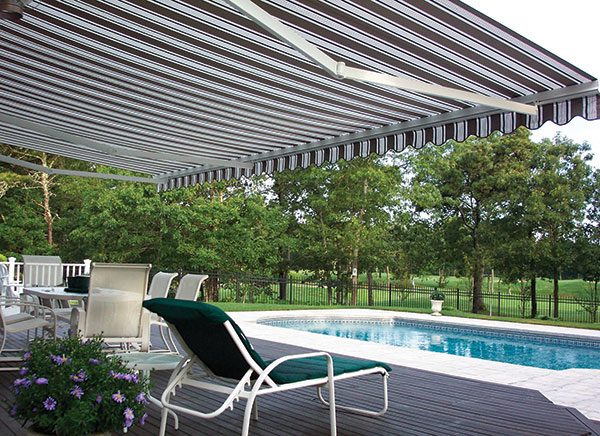
So your budget doesn’t allow for construction of a covered porch. Don’t fret. Retractable awnings can enhance your outdoor living experience for a fraction of the cost, all the while keeping you out of direct sunlight and heat, and saving on overall energy costs.
“Retractable awnings expand outdoor living space and help reduce direct sun glare and harmful UV rays. They allow you to stay outside longer,” says Larry Bedosky, marketing director of Eclipse Awning Systems, a leading national manufacturer located in Orange County, New York, just over the New Jersey border. “They provide sun protection not only for you, but for your furniture. And, they lower energy costs by blocking hot sun.” Industry reports claim that an awning can reduce heat gain by more than 50 percent.
Improvements in materials and design innovations have made retractable awnings more flexible and longer lasting than ever before. Lateral arms, roller tubes, connecting components and all-weather performance fabrics—Sunbrella, for instance, a leading manufacturer of indoor-outdoor fabrics, offers an eight-year warranty—are designed for carefree service.
And speaking of carefree: Motorization of retractable awnings is downright advanced—wind sensors will automatically retract an awning to protect it from high winds while sun sensors will extend the awning when the sun comes out. Somfy, the Dayton-based manufacturer of motors that go into most automated awnings, has been at the forefront of these advancements.
Retractable awnings are flexible for just about any space: An awning can be extended up to 16.5 feet to cover an entire deck or patio. They can be as narrow as 8 feet wide for a tighter space. Since all awnings are custom-fitted and custom-installed, and fabric choices are vast, pricing varies, says Bedosky. Good news: It typically takes less than two weeks from order to installation, he adds.
Awnings aren’t the only shading options. Solar shades or screens can be mounted on the exterior of the house, enclosing a porch or patio. The benefit, says Bedosky, is that they stop the heat before it even enters the home. (This, as opposed to the more common interior-mounted solar shades—“interior shades are much more affordable but are not quite as efficient at reducing sun glare and heat gain,” says Bedosky,) Another option is zipper screens—Eclipse makes a product called E-Zip—that create privacy along with a bug-proof environment. For both of these shading options you need to start with an area that can be enclosed. The best option, Bodesky says, is to call your local outdoor shading professional. Start by browsing these websites: eclipseawning.com; somfysystems.com; and sunbrella.com.
Click here to read about at painter’s paradise in Princeton.



